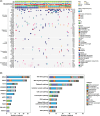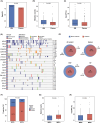Molecular characterization and biomarker identification in paediatric B-cell acute lymphoblastic leukaemia
- PMID: 39384181
- PMCID: PMC11464031
- DOI: 10.1111/jcmm.70126
Molecular characterization and biomarker identification in paediatric B-cell acute lymphoblastic leukaemia
Abstract
B-cell acute lymphoblastic leukaemia (B-ALL) is the most prevalent hematologic malignancy in children and a leading cause of mortality. Managing B-ALL remains challenging due to its heterogeneity and relapse risk. This study aimed to delineate the molecular features of paediatric B-ALL and explore the clinical utility of circulating tumour DNA (ctDNA). We analysed 146 patients with paediatric B-ALL who received systemic chemotherapy. The mutational landscape was profiled in bone marrow (BM) and plasma samples using next-generation sequencing. Minimal residual disease (MRD) testing on day 19 of induction therapy evaluated treatment efficacy. RNA sequencing identified gene fusions in 61% of patients, including 37 novel fusions. Specifically, the KMT2A-TRIM29 novel fusion was validated in a boy who responded well to initial therapy but relapsed after 1 year. Elevated mutation counts and maximum variant allele frequency in baseline BM were associated with significantly poorer chemotherapy response (p = 0.0012 and 0.028, respectively). MRD-negative patients exhibited upregulation of immune-related pathways (p < 0.01) and increased CD8+ T cell infiltration (p = 0.047). Baseline plasma ctDNA exhibited high mutational concordance with the paired BM samples and was significantly associated with chemotherapy efficacy. These findings suggest that ctDNA and BM profiling offer promising prognostic insights for paediatric B-ALL management.
Keywords: ctDNA; immune microenvironment; next‐generation sequencing; paediatric B‐cell acute lymphoblastic leukaemia; predictive biomarker.
© 2024 The Author(s). Journal of Cellular and Molecular Medicine published by Foundation for Cellular and Molecular Medicine and John Wiley & Sons Ltd.
Conflict of interest statement
The authors confirm that there are no conflicts of interest.
Figures





Similar articles
-
Unraveling the cellular origin and clinical prognostic markers of infant B-cell acute lymphoblastic leukemia using genome-wide analysis.Haematologica. 2019 Jun;104(6):1176-1188. doi: 10.3324/haematol.2018.206375. Epub 2019 Jan 24. Haematologica. 2019. PMID: 30679323 Free PMC article.
-
CD9 as a Potential Prognostic Biomarker in Paediatric B-Cell Acute Lymphoblastic Leukaemia.J Coll Physicians Surg Pak. 2025 Feb;35(2):191-196. doi: 10.29271/jcpsp.2025.02.191. J Coll Physicians Surg Pak. 2025. PMID: 39936197
-
High-throughput sequencing of peripheral blood for minimal residual disease monitoring in childhood precursor B-cell acute lymphoblastic leukemia: A prospective feasibility study.Pediatr Blood Cancer. 2022 Mar;69(3):e29513. doi: 10.1002/pbc.29513. Epub 2021 Dec 31. Pediatr Blood Cancer. 2022. PMID: 34971078
-
Early stage NSCLC - challenges to implementing ctDNA-based screening and MRD detection.Nat Rev Clin Oncol. 2018 Sep;15(9):577-586. doi: 10.1038/s41571-018-0058-3. Nat Rev Clin Oncol. 2018. PMID: 29968853 Review.
-
A CD10-negative adult B-lymphoblastic leukaemia with amplification of KMT2A without rearrangement: A case report and review of the English literature.Br J Haematol. 2024 Jul;205(1):364-367. doi: 10.1111/bjh.19520. Epub 2024 May 12. Br J Haematol. 2024. PMID: 38735761 Review. No abstract available.
Cited by
-
Advancing Leukemia Management Through Liquid Biopsy: Insights into Biomarkers and Clinical Utility.Cancers (Basel). 2025 Apr 25;17(9):1438. doi: 10.3390/cancers17091438. Cancers (Basel). 2025. PMID: 40361366 Free PMC article. Review.
-
Menin Inhibitors: New Targeted Therapies for Specific Genetic Subtypes of Difficult-to-Treat Acute Leukemias.Cancers (Basel). 2025 Jan 4;17(1):142. doi: 10.3390/cancers17010142. Cancers (Basel). 2025. PMID: 39796769 Free PMC article. Review.
References
-
- Hunger SP, Mullighan CG. Acute lymphoblastic leukemia in children. N Engl J Med. 2015;373(16):1541‐1552. - PubMed
MeSH terms
Substances
LinkOut - more resources
Full Text Sources
Research Materials

